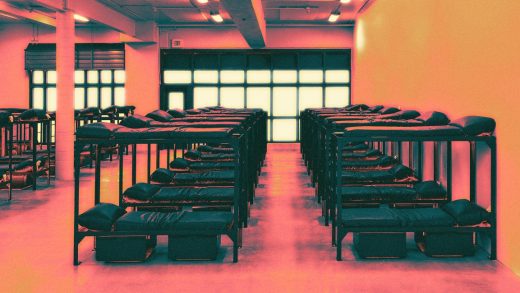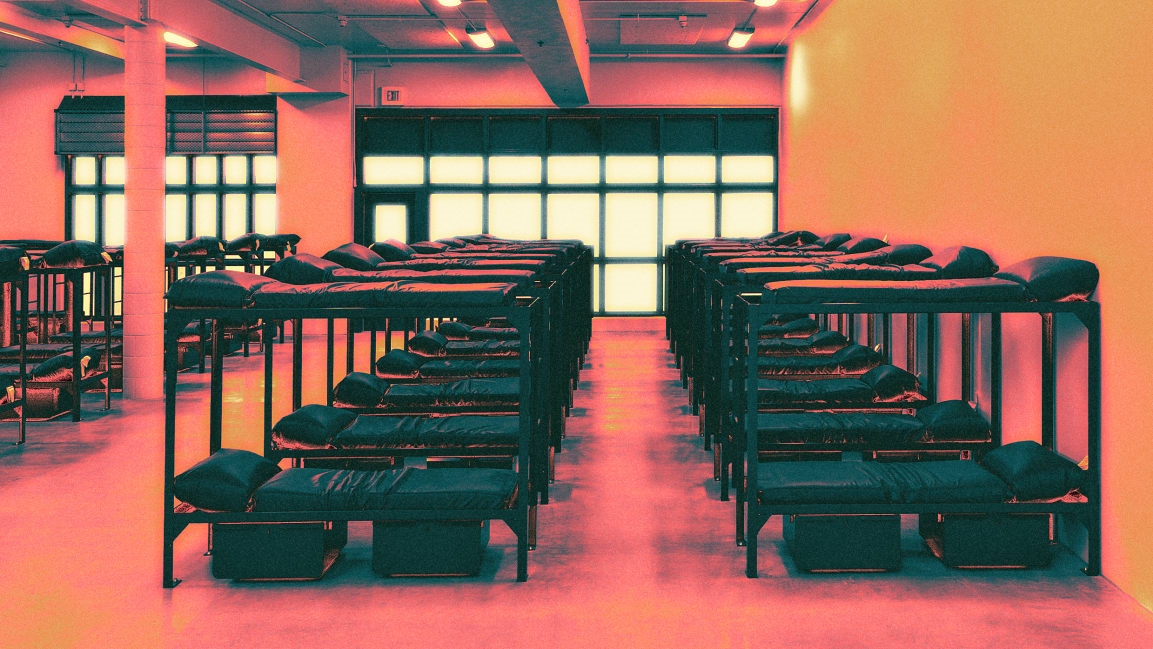Extreme heat is turning prisons into ovens
Whenever there’s a heat wave, Amite Dominick knows she’ll start hearing the stories: inmates intentionally flooding their toilets so they can lay down in the overflowing water to cool off; someone dreaming about rain only to realize it’s their bunkmate’s sweat dripping onto them from above. As the president of Texas Prisons Community Advocates (TPCA), an organization that supports incarcerated people and their family members, Dominick hears both directly from people inside prisons who send letters about the sweltering heat, and from family members who take to the group’s Facebook to share what their loved ones are experiencing whenever temperatures rise.
Extreme heat in prisons has been an issue for years. In 2014, a University of Texas School of Law report found that inside Texas Department of Criminal Justice (TDCJ) facilities, the heat index during summer can exceed 149 degrees Fahrenheit (heat index measures how hot it feels, with humidity included; a heat index at or above 103 degrees Fahrenheit can lead to dangerous heat disorders like heat stroke or heat exhaustion with prolonged exposure). To this day, out of 99 TDCJ units in operation, only 30 have air-conditioning in all areas; 49 have air-conditioning in “some” housing areas, a TDCJ spokesperson says, and 20 have no air-conditioning in housing areas at all.
Unprepared for climate change
This heat can be deadly—both from overheating and physical health complications, and the mental toll it can take; Lance Lowry, the former head of the Texas correctional officer’s union, told The Marshall Project that the number of attempted suicides among prisoners usually increases in the summer. As heat gets more extreme, prison facilities across the country are underprepared for this threat, leaving an already vulnerable community even more exposed to the dangerous effects of climate change.
It’s difficult to know just how well—or how many—prisons and jails are equipped to deal with extreme heat, because there are so many correctional jurisdictions spread throughout the U.S. “It means that you have not only an incredible range of diversity across the country from the standpoint of what got built when and how, but also what rules apply and who’s actually administering things,” says Daniel Holt, who worked for years as a criminal defense lawyer and wrote a paper while a visiting scholar at the Sabin Center for Climate Change Law about the issue of heat in prisons and jails.
But it’s becoming clear that more and more prisons are unprepared for rising temperatures: When the heat dome blanketed the Pacific Northwest in record-breaking high temperatures earlier this summer, prisons in the area without air-conditioning had to rely only on fans and swamp coolers, which need dry, not humid air, to work; advocates said correctional measures like providing ice water and breaks for inmates working outside were inadequate—or weren’t being implemented at all. Prison rights groups in Oregon wrote a letter to state officials calling on them to create a “robust and comprehensive emergency plan” for the state’s prisons—many of which lack functioning central air—in the event of future extreme weather.
“The people of Texas don’t want air-conditioned prisons”
What can prisons do to better prepare for extreme heat? Installing air-conditioning is one option. “They’re built with cement and metal, so basically, those are the same things you build an oven out of,” Dominick says of TDCJ units, particularly the handful that are more than 100 years old. “They’re literally baking in there.” And it’s not only the prisoners at risk either: “The heat conditions are just as bad for the officers as they are for our family members,” one person wrote on the TPCA Facebook page.
TPCA has been trying to address this issue for years with legislation that would require prisons to install climate control systems in all state-run facilities. That legislation passed the Texas House in May 2021 and then died in the Senate, right before the summer, after the committee to which it was referred failed to hold a public hearing on the bill. State Representative Terry Canales, the bill’s lead author, previously said the state’s refusal to address prison heat wasn’t an issue of money; “I think we have a give-a-damn problem,” he told the House Corrections Committee. (To some, even though the guards want cooler temperatures, the incarcerated people who would also benefit make unsympathetic subjects: “The people of Texas don’t want air-conditioned prisons,” one lawmaker said back in 2014.)
Installing air conditioning in prisons would be a costly undertaking—that Texas bill estimated $100 million for each of the three phases of installation it outlined. It takes time, too; those phases would have been two years each, and under that bill, all state prisons would be cooled below 85 degrees before 2029. But in the meantime, these facilities are already paying for the extreme heat in other ways. In 2019, the Texas legislature signed off on $1.8 million in payments to settle wrongful death lawsuits in the heat-related deaths of just three prisoners. That’s just one example. In the last decade, The Texas Tribune reports, at least 13 men have died of heat stroke while incarcerated, and dozens more—both inmates and guards—get sick, needing intravenous fluids.
Court records describe the heat as “cruel and unusual punishment,” detailing how stainless steel tables inside inmate dorms become “hot to the touch,” requiring prisoners to lay towels down before they put their elbows on the tables. Their metal beds, too, hold in heat, so inmates “routinely sleep on the concrete floor.” Before an inmate named Robert Allen Webb died in 2011, he told his brother he couldn’t keep cans of soda in his cell because they would explode, it was so hot. When his body was found, a prison chaplain told his brother “it was hot to the touch”, The Marshall Project reported.
Previously, the state had been involved in a yearslong lawsuit over installing air conditioning in the dorms at one minimum security prison that primarily housed “disabled, sick, and elderly” inmates, many whom are on prescription medication that can increase their risk of heat stroke. One plaintiff in that class action case testified that it was hard for him to write letters because “sweat drips all over his paper, and when he lies down, sweat pools in his eyes.” Another said they didn’t go to air-conditioned respite areas because of a policy that inmates seeking refuge from the heat in the infirmary must get their core body temperature measured with a rectal thermometer. That lawsuit settled in 2018, with the state of Texas spending a total of $7 million on the legal effort. The amount it would have cost to install air-conditioning from the beginning? Around $4 million.
Fewer people means easier cooling
Mandating humane temperatures (the Texas bill would have required temperatures between 65 degrees and 85 degrees Fahrenheit) inside prisons via air-conditioning is just one way to address this issue. Another would be to simply have fewer people in prison, permanently close the facilities that are in the most dire need of infrastructure repairs, and move the remaining prisoners into more modern facilities. “If we can shrink our prison populations in a way that keeps our civilian population safe, and the evidence says we can, and if we can do so in a way that allows incarcerated people to not fall into recidivism but actually make it outside of prison, and the evidence says that that is doable, than we should be doing that for a great many reasons,” says Holt.
In his 2015 paper, Holt laid out recommendations for the correctional industry to prepare for climate change, including retrofitting facilities to allow for passive cooling design—things like green roofs, awnings, and thermal windows that can naturally cool a facility and reduce the dependence on air-conditioning—and requirements for healthy temperatures as part of private prison contracts. (If a private operator can’t guarantee that people living and working there will be safe from extreme heat, then their contracts shouldn’t be renewed, Holt proposed). Another is to build new, sustainable facilities that are designed to be resilient against future climate changes. But the first suggestion he offers is to reduce the size of the incarcerated population.
“Decarceration, which is something that for a lot of other reasons we’re now taking seriously as a policy goal . . . is a great way of dealing with this problem [of heat],” he says. When it comes to regulating temperatures, prisons are a challenge because of how many people are packed close together; air-conditioning not only has to counter the temperatures outside, but cut through that body heat. Fewer people in prison could cool those facilities quickly and expose fewer people to the dangers of extreme heat.
Decarceration was used as a strategy to mitigate the risk of COVID-19 exposure in jails and prisons, too. Though there’s a concern some of those people may be sent back to prison, criminal justice reform advocates are urging officials to look at the practice as an example of a way we could more broadly overhaul the prison system. (Dominick was also hoping to address both the pandemic and heat risk through that Texas bill that would have required air-conditioning in prisons; if the state used stimulus funds, she says, it could install air purification systems that need to be connected to AC units, as a way to get more air-conditioning set up.)
Having fewer people in prisons would also help in other extreme weather scenarios. Installing air-conditioning only addresses heat, but as climate change worsens, so will flooding, extreme storms, and more, all of which pose an extra threat to people who are incarcerated. (In 2018, South Carolina did not evacuate its prisons for Hurricane Florence; it’s not the only state that has left prisoners in the path of natural disasters.) Some lawmakers are starting to focus on these issues; U.S. Senators Tammy Duckworth and Cory Booker recently reintroduced a bill that aims to improve disaster response and recovery efforts for prisons, broadly addressing natural disasters and public health emergencies.
But the question is still one of time: How long will it take for prisons to make those plans, or to retrofit facilities? When Holt wrote his paper on prisons and heat in 2015, he noted it was crucial to start these efforts immediately, writing then that “the hour is already late.” It’s a parallel to the way society has failed to address climate change writ large, but it’s also not an excuse to give up, or push action further down the road. “Each day that we’re inactive makes it a little bit harder, but we still have no choice,” he says. “We’re at the point at which, should a correctional administrator say, ‘I want to make sure that my facilities are properly adapted to climate change. I want to be the one who does that,’ they can do it. This is not an unsolvable problem.”
(34)



